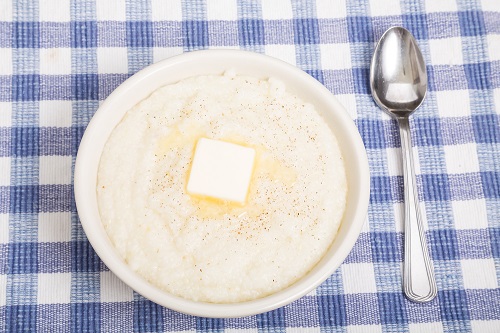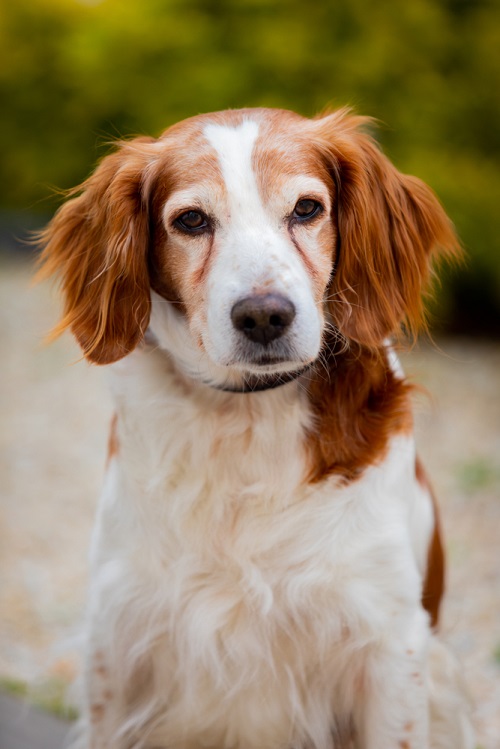Can Dogs Eat Grits? Why not! Give your pup a taste of the South with this tasty treat! Find ways of feeding it to dogs!
Can Dogs Eat Grits? If you are not sure about this, then don’t worry! This article will help you out with all the details you need!
What Are Grits?

People make grits by boiling ground corn kernels. Grits are a staple food widely enjoyed in the Southern United States, usually accompanied by toppings like cheese, butter, gravy, or others.
Read Can Dogs Get Brain Freeze here
Can Dogs Eat Grits?
Yes, dogs can eat grits. Moderation is crucial when it comes to giving human food to pets. Before offering grits to your pet, make sure to check for any added ingredients, such as butter, sugar, or salt, that may be harmful to them. .
Are Grits Good for Dogs- Health Benefits

Grits, which are made from ground corn, are not considered to provide significant health benefits for dogs. While corn itself can be included in some dog food formulations, it is important to note that dogs have limited ability to digest and extract nutrients from corn and other grains.
In terms of nutritional value, grits mainly consist of carbohydrates and have a relatively low protein content. Dogs require a balanced diet that includes appropriate amounts of protein, fats, carbohydrates, vitamins, and minerals to support their overall health.
Read Can Dogs Eat Dried Prunes here
Are Grits Bad for Dogs-Health Concerns
Grits themselves are not inherently bad for dogs when given in moderation. However, there are a few health concerns to consider:
- Digestive upset: Some dogs may have difficulty digesting grains, including corn-based products like grits. Consuming a large amount of grits or having a sensitive digestive system can lead to gastrointestinal upset, such as bloating, gas, or diarrhea.
- High carbohydrate content: Grits are primarily composed of carbohydrates, which can contribute to weight gain and potential blood sugar spikes in dogs, especially if consumed in excessive amounts. It’s important to monitor your dog’s overall carbohydrate intake and ensure it aligns with their specific dietary needs and activity level.
- Potential allergenicity: While uncommon, some dogs may have allergies or sensitivities to corn or grains. If your dog is known to have allergies or food sensitivities, it’s advisable to avoid feeding them grits or any corn-based products.
- Nutritional imbalance: Grits are not nutritionally complete for dogs on their own. Dogs require a balanced diet that includes appropriate amounts of protein, fats, vitamins, and minerals. Relying solely on grits for nutrition can lead to nutrient deficiencies over time.
If you decide to give your dog grits as an occasional treat, it’s important to cook them plain, without added seasonings or ingredients that could be harmful to dogs (such as salt, butter, or spices).
Related Foods of Grits Dogs Can or Can’t Eat
There are other varieties of grits and related foods that dogs can and cannot eat. Some examples include:
- Cornmeal: It is similar to grits and is made from ground corn. It is safe for dogs to eat in small amounts as a treat, but it should not be relied on as a primary source of nutrition.
- Polenta: Polenta is a type of cornmeal that is boiled and then served as a hot dish or allowed to cool and then sliced and fried or baked. It is safe for dogs to eat in small amounts as a treat, but it should not be relied on as a primary source of nutrition.
- Rice: Rice is a staple food for many people, but it is safe for dogs to eat in moderation as a treat. It is best to feed dogs white rice rather than brown rice, and it should be cooked without added spices or seasonings.
- Oatmeal: Oatmeal is a type of grain that is safe for dogs to eat in moderation as a treat. It is a good source of fiber and can help soothe an upset stomach.
Read Can Dogs Eat Prunes here
Are Hominy Grits Safe For My Dog?
Yes, hominy grits are safe for your dog to eat. However, as with all human foods, it’s important to feed them in moderation. Be sure to also check the ingredients list for any added spices or flavorings that may be unsafe for your pup.
How To Prepare Grits For Dogs
Grits should be prepared plain, without any added spices, seasonings, or butter, which can be harmful to dogs. Here’s how to prepare grits for dogs:
- Boil water in a pot and add the grits, stirring constantly.
- Cook the grits according to package instructions until they are soft and fully cooked.
- Remove from heat and allow to cool to room temperature.
- Serve the cooled grits to your dog as a treat.
Read Can Dogs Eat Almonds here
Can Dogs Eat Different Forms of Grits Like a Plain, White, and Yellow?

Yes, dogs can eat different forms of grits, such as plain, white, and yellow.
Grits are made from corn kernels that have been treated to remove the hull and germ. When feeding grits to dogs, it is important to only offer plain, unflavored grits without any added spices or seasonings.
All forms of grits, including plain, white, yellow, and hominy, should be served to dogs in moderation and should not exceed more than 10% of their daily calorie intake.
Read about Homemade Beef Lung Dog Treats here
Quick Takeaways
Dogs can eat grits as a treat, but not as their main source of nutrition.. It is best to feed plain, unflavored grits to dogs, as any added spices or seasonings can be harmful to their health
Have you ever given grits to your dog? Do you feed them to your pet frequently? Please share with us in the comments section below!
FAQs
1. Can Dogs Eat Grits and Eggs?
Yes, dogs can generally eat grits and eggs in moderation. Plain cooked grits and scrambled or boiled eggs can be a safe and occasional addition to your dog’s diet. However, it’s important to avoid adding any seasonings, spices, or ingredients like salt, butter, or onions, which can be harmful to dogs.
2. Can Dogs Eat Grits with Cheese?
Feeding dogs grits with cheese should be done with caution. While plain cooked grits are generally safe for dogs, cheese can be high in fat and lactose, which can cause digestive upset or lead to weight gain in some dogs. If you want to offer your dog grits with cheese, do so in moderation and ensure that your dog tolerates dairy products well.
3. Can Dogs Eat Grits with Butter?
It is generally best to avoid feeding dogs grits with butter. While small amounts of unsalted butter are unlikely to be toxic to dogs, the high fat content in butter can cause digestive issues and contribute to weight gain. It’s recommended to stick to plain cooked grits without added butter or other fatty ingredients for your dog’s overall health.
4. Can Dogs Eat Cheese Grits?
Feeding dogs cheese grits should be done with caution. Cheese grits combine two potential dietary concerns for dogs: cheese and grits. As mentioned earlier, cheese can be high in fat and lactose, which can cause digestive upset or weight gain in some dogs. While plain cooked grits are generally safe, the addition of cheese should be limited and monitored for any adverse reactions.
5. Can Dogs Eat Cooked Grits?
Yes, dogs can eat cooked grits in moderation. Plain cooked grits, without any added ingredients or seasonings, are generally safe for dogs.
6. Can Dogs Eat Corn Grits?
Dogs can eat corn grits in moderation. Corn is a common ingredient in many dog food formulations. However, it’s important to ensure that the corn grits are plain, cooked, and without any added seasonings or ingredients that could be harmful to dogs.
7. Can Dogs Eat Instant Grits?
Instant grits are typically processed and may contain additives or preservatives that are not suitable for dogs. It’s generally recommended to feed dogs plain, cooked, and unprocessed grits to avoid potential health issues.
